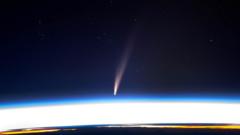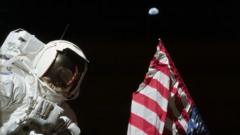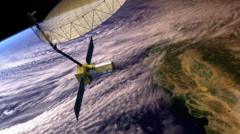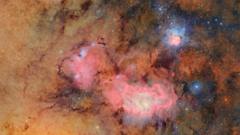Experts recommend southern hemisphere observations and provide tips for safe viewing.
**Rare Comet C/2024 G3 (Atlas) to Light Up the Skies for the First Time in 160,000 Years**

**Rare Comet C/2024 G3 (Atlas) to Light Up the Skies for the First Time in 160,000 Years**
A once-in-a-lifetime celestial event, Comet C/2024 G3 (Atlas) may soon be visible to human eyes after a lengthy absence of 160,000 years.
In an extraordinary astronomical event, Comet C/2024 G3 (Atlas), last visible around 160,000 years ago, is expected to dazzle skywatchers in the coming days. According to NASA, predicting a comet's brightness can be notoriously tricky; however, there is potential for this comet to be seen from Earth without the need for telescopes. As of Monday, the comet reached perihelion—its closest approach to the Sun—which is a key factor in determining its brightness.
While visibility specifics remain uncertain, experts are optimistic about the comet's potential to shine with a brightness similar to Venus. Dr. Shyam Balaji, a researcher at King's College London, noted that orbital calculations suggest a distance of about 8.3 million miles from the Sun during the comet’s trajectory, classifying it as a "sun-skirting" comet. Dr. Balaji emphasized that the next few days, especially around perihelion, will present the best opportunities to observe the comet depending on local weather and atmospheric conditions.
For optimal viewing, residents of the southern hemisphere should gaze toward the eastern horizon before sunrise, and after perihelion, check the western horizon after sunset. However, Dr. Balaji cautioned that with comets, brightness can vary significantly, and many end up appearing dimmer than initially predicted, making observation in the northern hemisphere potentially more challenging.
Individuals hoping to glimpse this cosmic wonder are advised to seek locations away from urban light pollution and consider using binoculars or small telescopes for enhanced visibility. Furthermore, safety precautions should be taken when stargazing during dawn and dusk. Real-time tracking of the comet's movement could also help enthusiasts locate it in the evening sky.
Over the weekend, NASA astronaut Don Pettit shared a striking image of the comet taken from the International Space Station, illustrating the significance and awe surrounding this rare event. He expressed his excitement on social media, reminding space enthusiasts of the wonders the universe has to offer. Stargazers will undoubtedly be keeping a watchful eye in hopes of catching a glimpse of this remarkable celestial visitor.
While visibility specifics remain uncertain, experts are optimistic about the comet's potential to shine with a brightness similar to Venus. Dr. Shyam Balaji, a researcher at King's College London, noted that orbital calculations suggest a distance of about 8.3 million miles from the Sun during the comet’s trajectory, classifying it as a "sun-skirting" comet. Dr. Balaji emphasized that the next few days, especially around perihelion, will present the best opportunities to observe the comet depending on local weather and atmospheric conditions.
For optimal viewing, residents of the southern hemisphere should gaze toward the eastern horizon before sunrise, and after perihelion, check the western horizon after sunset. However, Dr. Balaji cautioned that with comets, brightness can vary significantly, and many end up appearing dimmer than initially predicted, making observation in the northern hemisphere potentially more challenging.
Individuals hoping to glimpse this cosmic wonder are advised to seek locations away from urban light pollution and consider using binoculars or small telescopes for enhanced visibility. Furthermore, safety precautions should be taken when stargazing during dawn and dusk. Real-time tracking of the comet's movement could also help enthusiasts locate it in the evening sky.
Over the weekend, NASA astronaut Don Pettit shared a striking image of the comet taken from the International Space Station, illustrating the significance and awe surrounding this rare event. He expressed his excitement on social media, reminding space enthusiasts of the wonders the universe has to offer. Stargazers will undoubtedly be keeping a watchful eye in hopes of catching a glimpse of this remarkable celestial visitor.
















